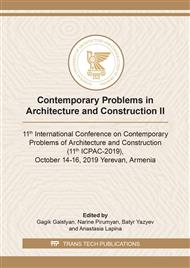[1]
V. Grigoryan, V. Khachatryan, Research and application of the method of making the mixture in the technology of reconstruction and repair work, Luys, Yerevan, (1995).
Google Scholar
[2]
A. Arzumanyan, M. Badalyan, A.Karapetyan et al., Research Methods for the physicomechanical general characteristics of building materials, textbook-tutorial, NUACA, Yerevan, (2017).
Google Scholar
[3]
O. Lyapidevskaya, E. Bezuglova, Concrete mixtures: Technical requirements. Test methods. Comparative analysis of Russian building codes: textbook, MSCU, Moscow, (2013).
Google Scholar
[4]
D.A Gurskiy, Turbina E.S, Calculations in MathCad 12, Piter, Saint Petersburg, (2005).
Google Scholar
[5]
M.G. Stakyan, M.А. Manukyan, A.G. Margaryan, Estimated assessment of fatigue resistance and crack resistance of parts working on air and in corrosive environments. № 2. Design schemes for determining the coefficients of strength and durability, Bulletin of Engineering Academy of Armenia. 4 (2004) 660-667.
Google Scholar
[6]
M.N. Stepnov, A.V. Shavrin, Statistical methods for processing mechanical test results: Reference book, Mashinostr., Moscow, (2007).
Google Scholar
[7]
M. G. Stakyan, E.A. Margaryan, Determination of the indicators of resistance to corrosion fatigue shafts on the results of optimal tests, Bulletin of Engineering Academy of Armenia. 8 (4) (2011) 709-714.
Google Scholar
[8]
V.P. Kogaev, Strength calculations at voltages variable in time, Mashinostroenie, Moscow, (2003).
Google Scholar
[9]
V.V. Klyuev, V.V. Bolotin, F.R. Sosnin et al., Reliability of machines, V. IV-3: Mashinostr., Moscow, (2003).
Google Scholar
[10]
G.V. Nevestov, Concretes, textbook-tutorial, Phoenix, Rostov-on-Don, (2011).
Google Scholar
[11]
N. Pirumyan, M.Stakyan, Bearing capacity of elements of a gas transportation system, XXII International Scientific Conference Construction the Formation of Living Environment, Form -2019, E3S Web of Conference. 97 (2019) 1-9.
DOI: 10.1051/e3sconf/20199704027
Google Scholar


